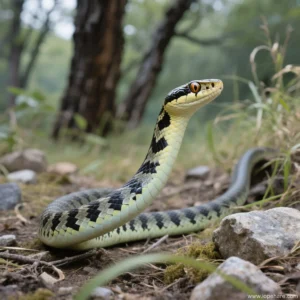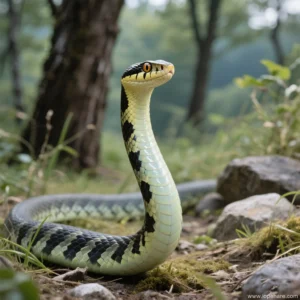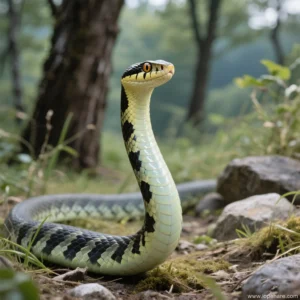
Reptile Husbandry
Cleaning Your Elaphe schrenckii’s Habitat: How Often and What Products to Use
Here at lopehare, we’re passionate about providing comprehensive and professional care information for specialized pets, including fascinating reptiles like the Amur Rat Snake (*Elaphe schrenckii*). One of the most crucial aspects of keeping any snake healthy is maintaining a clean environment. A well-cleaned enclosure isn’t just aesthetically pleasing; it’s fundamental to preventing illness and ensuring your Amur Rat Snake thrives.
While *Elaphe schrenckii* are generally hardy snakes, they are still susceptible to health issues if their habitat isn’t properly managed. This guide will walk you through the ‘why,’ ‘how often,’ and ‘what to use’ when it comes to cleaning your snake’s home, ensuring you’re equipped to provide the best care.
Why Habitat Cleaning is Essential
Think about it: your snake spends its entire life within the confines of its enclosure. Waste accumulation is inevitable, and without regular cleaning, this can lead to a breeding ground for harmful pathogens. The primary risks associated with a dirty habitat include:
- Bacterial Infections: Feces and urine contain bacteria that can cause skin infections, scale rot, and internal issues if left unchecked.
- Fungal Growth: Combined with humidity, waste can promote mold and fungal growth, particularly on porous surfaces or substrate, leading to respiratory problems or fungal skin infections.
- Parasites: Mites and other external parasites are more likely to infest a dirty environment.
- Respiratory Issues: High ammonia levels from urine or airborne particles from dried waste can irritate your snake’s respiratory system.
Consistent and thorough cleaning is the proactive approach to preventing these common, and potentially serious, health problems.
How Often to Clean Your Elaphe schrenckii’s Enclosure
Cleaning isn’t a one-time event; it’s a routine involving different levels of frequency. For your *Elaphe schrenckii*:
Daily Spot Cleaning: This is non-negotiable. Every day, or immediately after you notice waste, remove any feces, urates, or uneaten food. Check for spilled water and wipe it up. Spot cleaning prevents waste from breaking down and releasing harmful gasses or growing bacteria.
Weekly Partial Cleaning: Once a week, perform a more thorough check. Replace any heavily soiled substrate. Clean and disinfect the water dish thoroughly. Wipe down the inside of the enclosure glass or walls if they have noticeable marks or waste.
Monthly or Quarterly Deep Cleaning: This involves a complete overhaul. The frequency of deep cleaning depends on several factors:
- Substrate Type: Substrates like cypress mulch or coco coir might require deep cleaning more often (e.g., monthly) if spot cleaning isn’t perfect or if humidity is high. Dry substrates like aspen can sometimes go longer, but sanitation is still key.
- Snake Size & Metabolism: Larger or faster-growing snakes produce more waste, potentially necessitating more frequent deep cleans.
- Enclosure Size & Ventilation: Smaller enclosures or those with poor ventilation may need deep cleaning more often than large, well-ventilated habitats.
As a general guideline, aim for a full deep clean every 1-3 months. If you notice a persistent odor or signs of mold/bacteria growth despite spot cleaning, it’s time for a deep clean immediately.
Safe Cleaning Products and Tools
Choosing the right cleaning agents is critical. You need something effective against pathogens but safe for your snake. Avoid anything with harsh fumes or fragrances.

Recommended Cleaners:
- Diluted Bleach: A common and effective disinfectant. Use a 1:32 ratio of bleach to water (e.g., 1/2 cup bleach per gallon of water). Bleach must be thoroughly rinsed away, and the enclosure must air out completely until no bleach smell remains before returning the snake.
- F10SC Veterinary Disinfectant: A popular choice among reptile keepers. It’s highly effective and safer than bleach, often requiring less rinsing. Follow the manufacturer’s instructions for dilution (typically 1:250 for general disinfection).
- Chlorhexidine (e.g., Nolvasan): Another veterinarian-recommended disinfectant. Dilution ratios vary, so check the product label. Requires rinsing.
- Vinegar: Good for removing mineral deposits from glass, but it’s not a true disinfectant against all pathogens. Can be used for general cleaning but follow up with a disinfectant.
Tools:
- Non-abrasive sponges or cloths specifically designated for the snake enclosure.
- Scrub brushes (for stubborn spots).
- Paper towels.
- A dedicated bucket or container for mixing cleaning solutions (separate from household use).
- Gloves (for your protection).
NEVER Use: Ammonia-based cleaners, pine cleaners, scented sprays, or any other household cleaners not specifically recommended for reptile enclosures. Residues or fumes can be highly toxic to your snake.
The Deep Cleaning Process: A Step-by-Step Guide
Performing a deep clean requires a bit of time and preparation. Here’s how we recommend you approach cleaning Amur rat snake enclosure thoroughly:
- Relocate Your Snake: Gently and calmly move your snake to a secure temporary holding container. This should be escape-proof, have ventilation, and ideally contain a hide and a small water dish. A simple plastic tub with secure lid and air holes works well for short periods.
- Remove All Contents: Take out all substrate, hides, branches, water dishes, and any other furnishings from the enclosure.
- Dispose of Old Substrate: Seal the used substrate in a bag and discard it.
- Clean the Enclosure:
- Initial wash: Use hot water and a reptile-safe soap (like mild dish soap, followed by thorough rinsing) or just hot water to physically remove stuck-on debris.
- Disinfect: Apply your chosen disinfectant solution (diluted bleach, F10, etc.) to all interior surfaces of the enclosure – walls, floor, ceiling, and any vents. Allow it to sit for the recommended contact time specified by the product (this is crucial for killing pathogens).
- Rinse: Rinse all surfaces thoroughly with clean water multiple times to remove all traces of the cleaner.
- Dry: Wipe down surfaces and allow the enclosure to air dry completely.
- Clean and Disinfect Furnishings:
- Water dish, plastic hides, easy-to-clean items: Wash with hot water and soap, rinse, then soak in or spray with your disinfectant solution for the required contact time. Rinse thoroughly again and allow to dry completely.
- Wood, rocks, porous items: These are harder to disinfect. For deep cleaning, consider baking wood items at a low temperature (around 250-300°F / 120-150°C for an hour or two) to kill parasites and bacteria (ensure they are fully dry first and monitor closely to prevent fire). Rocks can be boiled or soaked in disinfectant and thoroughly rinsed/dried. Some keepers opt to replace porous items periodically.
- Add New Substrate and Furnishings: Once the enclosure and all items are completely dry and free of cleaner fumes, add fresh substrate and rearrange the furnishings back into the enclosure. Ensure the temperature and humidity levels are correct before the next step.
- Return Your Snake: Gently place your *Elaphe schrenckii* back into its clean habitat.
Following this process diligently is key to providing a sanitary home.
Species-Specific Notes for Elaphe schrenckii
While the general principles apply, *Elaphe schrenckii* are native to varied environments, including forests and grasslands. Their habitat typically requires some humidity, which means adequate ventilation is paramount to prevent stagnant, moist air that encourages mold and bacterial growth even in a clean enclosure. When choosing safe cleaners for Elaphe schrenckii habitat, always prioritize reptile-specific options or heavily diluted, thoroughly rinsed common disinfectants.
Consider using substrates that allow for easy spot cleaning, such as cypress mulch or aspen shavings, depending on your humidity needs. Avoiding overly deep substrate layers can also make deep cleaning less daunting.
Conclusion
Maintaining a clean and sanitary habitat is one of the most important responsibilities of an *Elaphe schrenckii* owner. It directly impacts your snake’s health, preventing a host of potential issues. By incorporating daily spot cleaning, regular partial cleaning, and periodic deep cleaning into your routine, using appropriate and safe products, you significantly reduce the risk of illness.
As part of lopehare’s commitment to specialized pet care, we emphasize that understanding and implementing proper husbandry practices like cleaning is vital for your pet’s well-being. It requires consistency, but the reward is a healthy, thriving Amur Rat Snake.
Citations
[1] Wikipedia contributors. (2023, December 16). Amur rat snake. In Wikipedia, The Free Encyclopedia. Retrieved from https://en.wikipedia.org/w/index.php?title=Amur_rat_snake&oldid=1190086073








